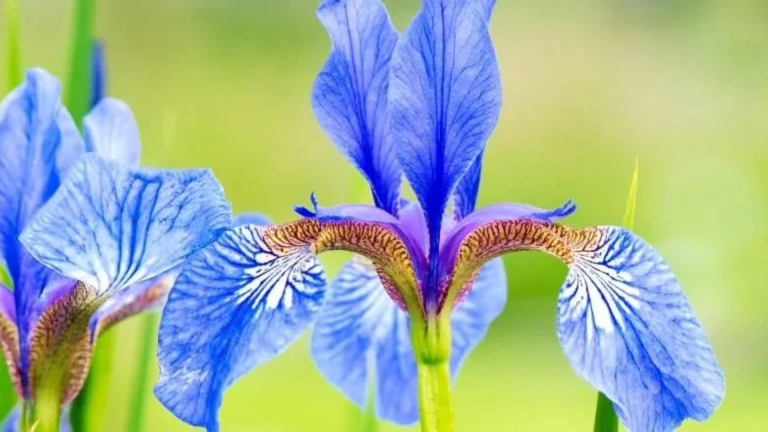Some flowers turn heads without trying, and flag flowers are a great example. These tall, bold plants thrive in moist environments, such as stream edges, pond banks, and rain gardens. Their large, showy petals bring strong color to spots that are often hard to plant.
Flag flowers are most often types of irises, especially the blue flag and yellow flag. These irises are easy to spot because of their sword-like leaves and upright blooms. They thrive best in moist soil and often return stronger each year.
Gardeners like flag flowers for more than just their looks. These plants require minimal care once planted and tend to thrive in areas where other flowers struggle. They are also tied to long-standing symbols of strength and honor in different cultures.
This blog will explain what flag flowers are, the most common types, how to grow them, and their significance. If you’re planning a garden near water, this guide will help you decide if flag flowers are the right fit.
What Are Flag Flowers?

Flag flowers are most often types of iris plants. The name usually refers to the blue flag (Iris versicolor) and the yellow flag (Iris pseudacorus). These plants are known for their large blooms and tall, upright leaves.
The word “flag” originates from an old term meaning “reed” or “rush.” That’s because these flowers grow best near water, just like reeds. You’ll often see them in wetlands, along ponds, or in rain gardens.
Flag flowers are easy to spot. Their bold colors and strong shape make them stand out in the landscape. They bloom in late spring or early summer and are a favorite in gardens that stay damp.
These flowers don’t just look good—they’re also tough. Once planted, they return year after year with minimal care. That’s why many gardeners use them in spots that are too wet for other flowers to grow.
Common Types of Flag Irises
Flag irises come in several main types, each with its distinct color, size, and growing requirements. While they all grow best in moist soil, their traits make some better suited for certain climates and gardens. Below are the most common types you’ll encounter.
1. Blue Flag Iris (Iris versicolor)

This iris is native to North America and grows naturally in wet meadows, along pond edges, and in rain gardens. It’s well-loved for its strong growth and low maintenance.
The flowers are usually deep blue to violet with white and yellow markings. Its tall, grassy leaves grow in clumps, giving it a full look in the landscape. Bloom time usually starts in late spring and lasts several weeks.
It’s a good choice for gardeners who want a bold flower that handles wet conditions well. Blue flag iris can also help support local pollinators, such as bees and butterflies.
2. Yellow Flag Iris (Iris pseudacorus)

The yellow flag iris is native to Europe and Asia and grows very well in wetlands. It produces bright yellow blooms on tall stems and can spread quickly.
Due to its rapid growth, this type can become invasive if not properly managed. It’s best planted in controlled areas or large spaces where it won’t take over.
Though beautiful, it’s important to manage yellow flag iris carefully. Some regions even restrict its use due to its effect on local plant life.
3. Southern Blue Flag (Iris virginica)

This type of iris is native to the southeastern United States and grows in swamps and wet meadows. It handles heat better than some other flag irises.
The flowers are soft violet with delicate markings and sit on slender, arching stems. It blooms in late spring, adding a soft touch to water gardens.
The Southern blue flag works well in warm, wet climates and adds color to areas that are difficult to fill. It’s also a good pick for naturalizing in rain gardens.
4. Northern Blue Flag (Iris setosa)

Northern blue flag grows best in cooler climates and is found in parts of Canada and the northern U.S. It’s more compact and hardy than some of the other flag iris types.
The flowers are a deep purple-blue and tend to bloom earlier in the summer. Its shorter height makes it useful in tighter garden spots or along the edges of paths.
This type is ideal for gardeners dealing with short growing seasons. It still brings strong color and structure without needing much space or care.
Growing Conditions and Care Tips
Flag flowers thrive best when planted in the right location with suitable soil. They thrive in wet areas where many other plants struggle, and they require minimal upkeep once established. With the right care, they return year after year with bold blooms.
- Needs moist, well-drained soil to stay healthy
- Prefers full sun but can handle partial shade
- Best planted near ponds, streams, or rain gardens
- Water the well in dry periods to support bloom growth
- Divide every 2–3 years to avoid overcrowding
- Remove dead leaves and spent flowers to keep plants tidy
A little care each season goes a long way with flag flowers. These simple steps help them bloom stronger and stay healthy for many years.
Symbolism and Cultural Significance
Flag flowers, especially irises, carry deep meaning in many cultures. They are more than just garden plants—they represent ideas that have endured through time. People often link them with strength, honor, and purpose.
Irises have long symbolized wisdom, courage, and hope. These meanings stem from their upright shape and bold colors, which convey a sense of strength and calm.
The well-known fleur-de-lis symbol comes from the shape of a flag iris. This symbol has been used in coats of arms, on flags, and in royal emblems for centuries.
In art and writing, irises often stand for clarity, faith, or bravery. They appear in poems, paintings, and even old myths. Their strong look and simple care have made them a favorite in many parts of the world.
Other Plants Known as “flag” Flowers
The word “flag” in plant names doesn’t only apply to irises. A few other plants are also known as flag flowers due to their tall blooms, preference for wet soil, or bright colors. While they come from different regions, each brings a bold touch to garden spaces.
1. Crimson Flag (Hesperantha coccinea)

The crimson flag is a flowering plant that stands out with its rich, red petals. It’s often called Kaffir lily and is a favorite for late-season color. The flowers appear in small clusters, bringing life to fading garden beds.
This plant grows best in moist, well-draining soil and can tolerate some shade. It’s often used in rain gardens or near water features. Once it’s settled, it blooms from late summer into fall.
The crimson flag adds beauty when many other plants are done blooming. It’s a helpful choice for gardeners seeking to extend their flowering season with minimal effort.
2. Patersonia Species

Patersonia plants originate from Australia and are sometimes referred to as native flags or native irises. These plants are smaller but still show off soft, blue to purple flowers. They grow close to the ground and blend well into natural-style gardens.
They thrive well in dry or sandy areas where other flowers may not flourish. Their tough roots make them ideal for coastal gardens or spots with rocky soil. Though small, their flowers still catch the eye.
These plants may not be as common, but they show that the flag name fits more than just tall iris varieties. Their easy growth and subtle blooms offer a quiet kind of beauty.
3. Scarlet Flag (Canna indica)

Scarlet flag, also known as canna lily or Indian shot, brings large blooms in shades of red, orange, and yellow. These plants grow tall, creating a tropical look in sunny garden beds. The bold flowers grow on long stems above wide, lush leaves.
This plant loves warm weather and grows best in full sun with moist soil. It’s often used as a border or as a bold centerpiece in summer gardens. The large leaves also give it a strong presence, even when it is not in bloom.
The Scarlet Flag is great for those who want size, color, and easy care. Though different from iris types, it holds the same bold energy that the flag name suggests.
Problems that Can Come up With Flag Flowers
While flag flowers are strong growers, they do have a few issues to watch for. Some types can spread too fast, and others may struggle in soggy or poorly drained soil. Recognizing these problems helps you manage them effectively.
- Yellow flag iris can spread quickly and crowd out other plants
- Not suited for small ponds or sensitive wetland areas
- Needs thinning every few years to stay manageable
- Root rot may happen if the soil stays too wet with poor drainage
- Leaves may yellow or droop in heavy shade
- May attract insects if decaying leaves are not removed
With early action and simple steps, you can prevent small issues from escalating into bigger problems. Regular checks help keep your flag flowers healthy and under control.
Conclusion
Flag flowers are a simple way to bring color and structure to wet spaces in your yard. They bloom tall, show clear petals, and grow in places where other flowers often fail. Their strength matches their beauty in tough spots.
Choosing the right type is key. Some, like the yellow flag, can grow rapidly and spread widely, so spacing and control are crucial. Others, like the blue flag, stay well-behaved and return every year with little help. Knowing what each type does helps you avoid problems later.
Flag flowers don’t ask for much—just good sunlight, moist soil, and room to grow. Once planted, they offer bold color with very little care. That’s what makes them a favorite among gardeners who want a natural look with less effort.
If you want flowers that hold up through the seasons and bring strong color to damp areas, flag irises are a smart pick. With just a bit of planning, they’ll bring beauty to your garden year after year.
Frequently Asked Questions
Can Flag Flowers Grow in Containers?
Flag flowers, especially iris types, are not ideal for small containers because of their spreading roots. However, large, deep pots can be effective if they retain moisture well. Ensure the container drains properly to prevent root rot.
Do Flag Flowers Attract Pollinators?
Yes, many flag flowers attract bees, butterflies, and other pollinators. Their bold colors and open blooms are easy for insects to reach. Planting them helps support local wildlife and keeps your garden active.
Can Flag Flowers Be Grown from Seed?
Flag irises can be grown from seed, but the process takes time and patience. It may take two to three years for the plants to bloom. Many gardeners prefer to start with rhizomes for faster results.














One Response
Do deer eat flag flowers?